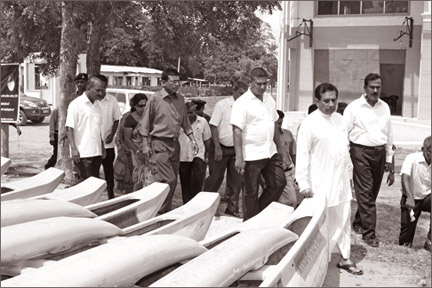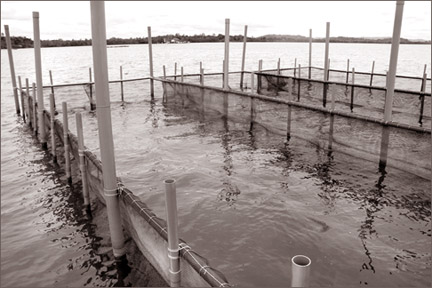Aquaculture for food security, economic development
Jayantha CHANDRASOMA
Aquaculture is the husbandry or farming of aquatic plants and animals
and its practices range from the propagation of aquatic organisms under
complete human control to the manipulation of at least one stage of an
aquatic organisms life before harvest for the purpose of increasing
production for profit or social benefit. Aquaculture has a long history.
First book on fish culture was written by Fan Lee, in 475 B.C. This
book covered topics such as pond construction and spawning of fish. The
term ‘Aqua husbandry’ was first described in this book. There had been
evidence to indicate that Oysters were cultured by Romans in 100 B.C.
and Milk fish culture practised in Indonesia in 1400 A.D.
Importance
Fish farming has been practised more at subsistence level for
centuries and grown into a industry during last four decades. The recent
interest and development in aquaculture basically due to growing demand
for fish protein; limitations in production from capture fisheries; high
production rate per unit area of aquaculture operations; less dependency
on fuel; Economic viability of aquaculture enterprises; Ability to
supply quality sea food, especially fresh and live etc.
 |
|
Fisheries and Aquatic Resources
Development Minister Dr Rajitha Senaratne inspecting some
boats which are to be distributed among Northern fishermen. |
 |
|
Freshwater
prawn farming |
Fisheries and aquaculture are widely considered to make important
contributions to meeting the United Nations Millennium Development Goals
of poverty, elimination, food security and nutrition. Most governments
has recognized Aquaculture and Inland Fisheries as priority area for
development considering important role it can play in enhancing food
security, nutrition, employment, livelihoods and for earning foreign
exchange and economic development. Some other roles of aquaculture are
culture of fish for baits
(eg. milk fish), ornamental fish culture, culture of natural food for
fish, improvement of natural stocks, control of organic pollution and
culture of fish for recreation activities such as sports fishing.
Status of global aquaculture
Capture fisheries and aquaculture supplied the world with about 142
million tonnes of fish in 2008. Of this, 115 million tonnes was used as
human food, providing an estimated apparent per capita food supply of
about 17 kg. aquaculture accounted for 46 percent of food fish supply.
Fish accounted for 15.7 percent of the global population’s intake of
animal protein. China is the largest fish producing country, with a
production of 47.5 million metric tones in 2008; 32.7 and 14.8 million
tonnes from aquaculture and capture fisheries respectively.
Aquaculture production
While the fish supply from marine capture fisheries appears to have
reached a plateau, the demand for fish and fish products is rising.
This increasing demand is being met by aquaculture with an average
growth rate of eight percent over the past two decades. Aquaculture is
the fastest growing food producing sector in the world and remains a
growing, vibrant and important production sector for high protein food.
The combined result of development in aquaculture worldwide and the
expansion in global population is that the average per capita supply of
food fish from aquaculture for human consumption has increased by 10
times, from 0.7 kg. in 1970 to 7.8 kg. in 2008, at an average rate of
6.6 percent per year.
Aquaculture produced 15.8 million tonnes of aquatic plants (mainly
seaweeds) in 2008, with a total estimated value of US $ 7.4 billion.
Ninety four percent of world total production of aquatic plants come
from aquaculture sea weeds are used for direct human consumption or for
extraction of carrageen-an and other substances, which are important for
food processing industries.
Asia’s dominance
Asia is the cradle of global aquaculture and it is not only the
region with the highest contribution to global aquaculture (over 90
percent) but also the region with the highest average food fish
consumption rate, estimated at 29kg person per year. Eight Asian
countries are among the top ten aquaculture producing countries in the
world. These countries are China, India, Vietnam, Indonesia, Thailand,
Bangladesh, Philippines and Japan.
The structure of the sector in much of the region is characterized by
the pre-dominance of production from small-scale farms. Growing
Aquaculture Sector provides significant opportunities for employment,
directly and indirectly in production or value chain.
Major species groups used in aquaculture
Aquaculture is being carried out using freshwater, brackish water as
well as seawater. Aquaculture operations in freshwater contribute 60
percent to world aquaculture production by quantity. The production of
freshwater fish is dominated by carps. Other freshwater fish community
used in aquaculture are Tilapia species and Pangas Catfish. Aquaculture
in marine waters produce many high valued crustaceans and finfish,
shrimp and prawns, oysters, mussels, clams and scallops. Brackish water
production represented 7.7 percent of world aquaculture production and
consisted of high valued shrimps and fin fishes.
Challenge
Given the population growth, in order to maintain the current global
per capita fish consumption of 17 kg/per person, it is estimated that
138 million tones of food fish will be required by 2025. An increase of
22 million tones from 2008 level. Provided that the current supply of
fish from capture fisheries is maintained, this increase of 22 million
tonnes should be obtained from Aquaculture and Inland fisheries. It is
important to ensure this is achieved in a sustainable and responsible
manner and particularly as ecosystems come under increasing pressure
that resources are wisely utilized to ensure that people continue to
benefit from the consumption of fish for generations to come.
Sri Lanka - resources
Sri Lanka is rich in water resources required for development of
inland fisheries and aquaculture. There are 103 perennial rivers in Sri
Lanka. Most of which, drain from the central islands into the Western,
Southern and Eastern coasts. In addition, there are more than 12,000
reservoirs with an extent of about 300,000 ha.
The extent of reservoirs in Sri Lanka consists of the ancient
reservoirs that have been restored and rehabilitated and new reservoirs.
These reservoirs have been constructed primarily for irrigation and
for generation of hydro-electricity. Sri Lanka has the highest density
of reservoirs (around 4.0 ha for every km of the island) in the world.
In addition, there are around 170,000 ha. of Lagoons and estuaries. Sri
Lanka has a coastline of 1770 km.
Considering the vast resources available, its potential for
development and role of inland fisheries and aquaculture sector in
providing food security, nutrition, livelihoods to the rural communities
and for strengthening rural economy, government has accorded a high
priority for the development of this sub-sector under ‘Mahinda
Chinthana’ of President Mahinda Rajapaksa. Realizing the importance of
this sub-sector the President established the National Aquaculture
Development Authority of Sri Lanka (NAQDA) in 1998 when he was the
Fisheries and Aquatic Resources Development Minister.
NAQDA
NAQDA is the leading agency for the development of Inland fisheries
and Aquaculture in Sri Lanka, falling under the purview of the Fisheries
and Aquatic Resources Development Ministry. It was established under
National Aquaculture Development Authority of Sri Lanka, Act No.53 of
1998.
Its functions include develop aquatic resources and the aquaculture
including: creation of employment opportunities through the development
of freshwater and coastal aquaculture; farming of high valued species
for export; promote the optimum utilization of aquatic resources through
environmental friendly aquaculture; promote private sector investments
in aquaculture; manage, conserve and develop resources, conserve
bio-diversity etc.
NAQDA has three main divisions for Freshwater Aquaculture, Coastal
Aquaculture and Aquaculture Extension. NAQDA operate three large
freshwater food fish seed production centres (Udawalawe, Dambulla and
Inginiyagala), two centres for Ornamental fish (Rambodagalla,
Ginigathena), and two Freshwater prawn hatcheries (Pambala,
Kandamodara). In addition NAQDA operater a marine shrimp hatchery at
Batticaloa with a private sector partner. A training centre with all
facilities has been established at Kalawewa. Two shrimp farm monitoring
units at Chilaw and Batticaloa to support and regulate shrimp farming.
NAQDA’s aquaculture extension service consist of network of District
Aquaculture Extension officers established in almost all districts for
implementation of development activities and for the regulation of the
sub sector.
Present status fisheries industry contributes two percent to the GDP
of the country. More than 70 percent of the animal protein requirement
of Sri Lankans are obtained through consumption of fish. Total fish
production in Sri Lanka in 2010 was 3,84,670 tonnes, of which 52,410
tonnes (13.6 percent) came from inland fisheries and aquaculture. Fish
production from inland fisheries and aquaculture sub-sector showed an
average annual growth rate of twelve percent during last five years.
Inland Fisheries and Aquaculture play an important role in providing
good quality fish at affordable prices to rural communities. It was
interesting to note that per capita fish consumption in districts such
as Anuradhapura and Polonnaruwa is high (13.5 kg./annum), when compared
to national average of 11.6 kg. 85 percent of the fish consumed in these
districts are inland fish.
There are about 75,000 people engaged in activities related to inland
fisheries/aquaculture directly and indirectly. Inland fisheries and
aquaculture plays an important role in strengthening rural economy. For
example inland fisheries in Mahavilachchiya tank produces around 700
tones of fish annually. Estimated value of this fish is around Rs 90
million and this is a major contribution to the economy of the area.
Development activities
Sri Lanka’s inland fisheries and aquaculture development programmes
consist of, enhance fish production in large reservoirs through stocking
of fish fingerlings and management of fisheries; Introduction of
culture-based fisheries in medium and minor perennial reservoirs and
seasonal reservoirs; Increase fish seed production with the
participation of communities and the private sector; Rehabilitation of
shrimp farming in Puttalam district and extend shrimp farming to North
and East; Development of inland fisheries and aquaculture in North and
East; Promote and support coastal aquaculture including sea cucumber,
sea bass, milkfish, bi-valve and seaweed culture; promote freshwater
fish and freshwater prawn farming in ponds and cages; promote and
support ornamental fish and ornamental plant industry to enhance
exports.
It is anticipated that fish production from inland fisheries and
aquaculture will reach 9,500 metric tonnes by 2013, through the
implementation of above development progammes.
(The writer is a Senior Aquaculture Scientist with wide experience in
Inland fisheries Aquaculture sub-sector. At present he is the National
Aquaculture Development Authority of Sri Lanka Chairman)
|



